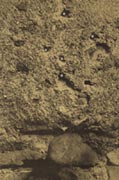by Thomas Girst
|
||||||||||||||||||||||||||
The subsequent paper is based on parts of a lecture first held at a three-day Marcel Duchamp symposium, which, accompanied by a small exhibition of works by the artist from the museum's own collection, took place between November 23-25, 2001, at the Hessisches Landesmuseum Darmstadt, Germany. What follows is intended to highlight the significance of Duchamp's 1945 window display of Breton's second and expanded edition of art theoretical writings, " Le Surréalisme et la Peinture," (Fig.1) for the production of his last major work, Given: 1. The Waterfall/2. The Illuminating Gas (Figs. 2 and 3). In the process, I attempt to predate Duchamp's active involvement with this work and to shed some new light on the relationship between Marcel Duchamp and Maria Martins, his lover at the time, as well as Enrico Donati and Isabelle Waldberg, both of whom were involved with the construction of the shop window display. In the process, a new work by Duchamp will be introduced. In addition, the overall significance of the art dealer Julien Levy and René Magritte's painting Le Modèle Rouge (1935) (Fig. 4) for all of the above shall be examined. On November 10th, 1945, the Swiss artist Isabelle Waldberg included a drawing in one of her many letters to her husband Patrick, living in Paris at the time. "Yesterday morning, we did the window at Brentano’s Surréalisme et la peinture," she writes (1) . "Marcel naturally did everything, all design and execution. Here’s a drawing of it:" (Fig. 5)
Within the drawing, Waldberg points out various objects that can be seen from the perspective of a full frontal view of the window display. On the left is a "chicken wire mannequin bought ready-made," on the right are "boots with toes painted by Donati." In the center, towering above the "books" is "an object by me underneath the tent." She defines the tent as "old paper from M.'s studio en chute."
"chicken wire mannequin bought ready-made"
Two small circles within the drawing by Isabelle Waldberg define the protruding breasts of the chicken wire torso, yet from the remaining photograph of the window display it is impossible to tell whether the mannequin is feminine or masculine. In any case, only two years before, for the back cover of VVV (New York, nos. 2-3, March 1943) André Breton's Surrealist publication in exile, Duchamp had designed a die-cut woman's profile into which chicken wire was inserted (Fig.6). This see-through miniature torso was to be used for the Twin-Touch-Test, explained on the magazine's last page (Fig.7): "Put the magazine flat on a table, lift back-cover into vertical position, join hands on both sides of screen, fingertips touching each other and slide gently along screen towards you." The goal was to experience an "unusual feeling of touch" that the readers were asked to share with VVV. A double-exposure photograph of a slightly ecstatic looking Pegeen Vail (Peggy Guggenheim's daughter) (2) demonstrated the Twin-Touch-Test while the editors announced a total of five prizes for the best submissions. The VVV design would not be the only time that chicken wire was to appear in Duchamp's oeuvre. In 1962, for the exhibition of Surrealist Intrusion in the Enchanter's Domain, (D'Arcy Galleries, New York, November 28, 1960 - January 14, 1961) Duchamp installed a surrealist environment for the show (he also designed the catalogue) involving many rooms. In one of them Duchamp used a cupboard to house three white chickens. Lit by a green light, a sign above the poultry, made of nickel coins, spells: Coin Sale (Fig.8) (3) . Pronounced in French, "coin sale" means "dirty corner," a derogative term for the female gender. Here, the chicken wire is used to keep the hens in place. A third instance involving chicken wire is Duchamp's altered Family Portrait of 1964 (Fig.9). When compared to the 1899 original (Fig.10) (4) , it becomes apparent that what is missing in the photomontage are not only members of Duchamp's family but also the chicken wire fence running behind both sides of the people gathered for the portrait. >>Next
Notes
2.Arturo Schwarz, The Complete Works of Marcel Duchamp (New York: Delano Greenidge, 1999), p. 772. A
year before Duchamp's back cover for VVV, he had designed the
catalogue for the First Papers of Surrealism exhibition (New
York, October 14 – November 7, 1942), the front cover of which depicts
a close-up of bullet traces on the wall of a barn on Kurt Seligmann's
property in Sugar Loaf, New York (see a related article, Shooting
Bullets at the Barn, in the Notes-section of Tout-Fait
2, 2000). With chicken and small livestock inside, the only door of
the barn was in part made of chicken wire.
Figs.
1-3, 6, 8, 9,
Footnote2
|
||||||||||||||||||||||||||























